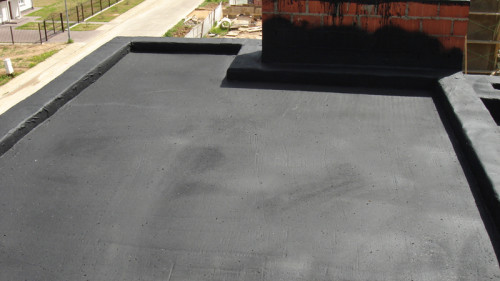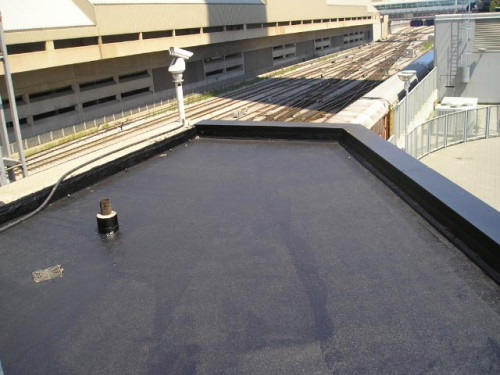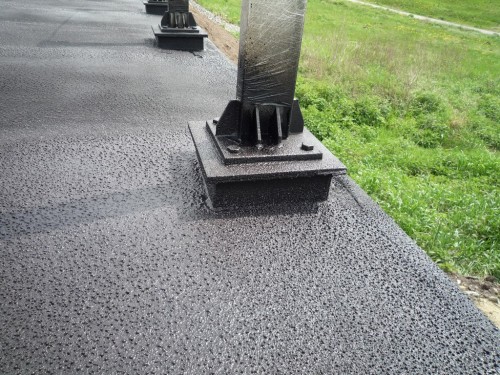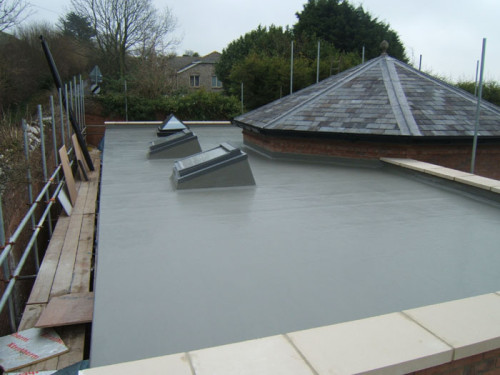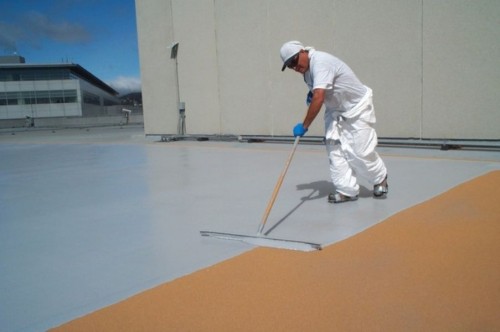The arrangement of liquid waterproofing of the roof is an effective way to protect the building from moisture, precipitation, low temperatures and other environmental factors. You can make a liquid roof with your own hands, and in this article we will talk about how to do such a job.
Content
Why do you need a liquid roof
An unfavorable climate that reigns in many regions of our country leads to the fact that many building materials lose their operational properties over a short time. Low temperatures and sharp temperature fluctuations can deform the roofing. So, roofing material and other similar products quickly become unusable, losing the ability to waterproof.
Among modern, better and more durable materials, liquid rubber for the roof can be distinguished. It is applied to the surface in a "cold" way, that is, without warming up, which marks the process of work noticeably. Such a roof is characterized by increased strength, it is seamless, elastic and capable of serving much longer than leaf and rolled waterproofing. The economy of the coating is associated with this quality, although it costs noticeably more than the same roofing material. But, unlike roofing material, it will not have to be repaired every 1-2 years, liquid rubber serves for decades, without bursting, without cracking and without breaking.
Advantages of roof waterproofing with liquid rubber
- Liquid rubber allows you to create a monolithic coating without a single seam on the surface. It has not only joints, overlaps and seams, but also microcracks through which moisture can fall into the roofing cake and spoil the lower materials.
- Most rolled materials are mounted on the roof by warming up. If you do not heat the sheet itself, then be sure to melt the mastic on which it is glued. And at some construction sites, for certain reasons, the use of fire is not allowed. With a liquid roof, which is applied to the surface in a “cold” way, such a problem will not arise.
- Liquid rubber has increased elasticity, which allows it to transfer temperature changes, the range of which is from -50 ° C to +100 ° C. Even under such adverse conditions, the material does not exfoliate, does not deform, does not crack, and does not even soften.
- Quick repair of liquid roof is another of its undoubted advantages. Even if damage is formed on the surface for some reason, they can be poured with the same composition, but in the case of rolled material you will have to change a whole fragment of the sheet.
- The repair of a liquid roof is also simple because it is very easy to find a leak on it and immediately close it up. On rolled agents, damage is not so noticeable and determined.
- Liquid rubber for roof allows you to work with complex objects and areas, for example, drains, mines and vertical elements. It is much easier to apply it to such zones, but the roll material will have to be cut and stacked in a certain sequence.
- A similar type of waterproofing is highly durable, in addition, it can be additionally increased by adding special sprinkling between the coating layers or bedding glasses.
- Rolled materials in no case should be laid on a wet roof, otherwise they will quickly eliminate. With a liquid roof, this requirement is not necessary, since the rubber adheses perfectly with almost any surface.
- Liquid waterproof for the roof can be used in combination with rolled agents.
- Liquid rubber is used to waterproof surfaces not only from the outside, but also indoors, and its installation is much simpler and faster than a roller coating.
- The water -repellent properties of the material under consideration are much higher than that of other analogues.
- Liquid waterproofing of the roof has a small mass and does not provide a noticeable load on the building of the building. Rubber consumption is approximately 1.5-2 kg per 1 m², while a layer of 1.5-2 mm thick is created on the surface.
- The simplicity of working with the material is that you do not need to cut the sheets and perform a certain sequence of styling, creating reinforcing layers. Using the method of spraying with liquid rubber in 1 day, you can cover an area of \u200b\u200b600 m².
- You can subsequently paint the roof waterproofed in this way in any shade you like.
- Such a mastic freezes very quickly. A strong clutch with the base occurs faster than 1 minute, and after half an hour the roof can withstand minor physical influences, for example, you can walk along it.
- The liquid roof is not afraid of ultraviolet radiation, it is resistant to most chemicals, is not damaged by salt water, alkaline and acidic compounds, gasoline, oils. Microorganisms and mold do not start in it.
Liquid waterproofing for the roof requires minimal labor and time costs, and although it costs more than many other materials, the durability of use with more than pay for all expenses.
Scope of use of liquid polymer roof
- Most often, waterproofing of this type is used in the construction of residential and industrial facilities. Since liquid polymer coating has increased strength, it can be used on the roofs, which will subsequently be actively operated. For example, on such a roof you can equip a parking lot for cars, create a garden, a recreation area, etc.
- With the help of such mastics, you can restore soft roofs.
- It is convenient to use liquid rubber for waterproofing complex areas: ventilation ducts, chimneys, parapets, pipe output places, etc.
- Using such compounds, you can waterproof balconies and loggias, as well as visors.
- Polymer mastics are indispensable in industrial buildings, especially where it is impossible to use fire when laying roll materials.
Types of liquid roof
By the number of components that are part of the material, such types of liquid rubber are distinguished:
- One -component - is a multi -color mass that does not need in advance preparation and can be used immediately.
- Two -component is a composition that includes a base and a special hardener. Its components are mixed before application.
According to the application method, there may be:
- Painting - applied to the surface with a brush or roller, like ordinary paint. Most often it is a liquid or pasty mass.
- Subtated - such rubber is a liquid that is supplied through a special installation and quickly spilled onto the working base.
- Inflorious - this mass is prepared immediately before work, then spilled onto the roof area and leafed.
With a sprayed or bulk method, rubber penetrates into the smallest cracks, pores and cracks, closing them from moisture penetration and creating a very durable and reliable protection.
Methods of applying liquid waterproofing
Mechanized method
Depending on the availability of materials, tools, devices, as well as on the technical capabilities and type of coating, are determined with the method of applying liquid waterproofing. This can be done manually or use a special airless injection unit. It should be noted here that to work with it you need certain skills and skills, and if you are not sure that you can do such work, then it’s better not to risk it and apply a manually coating.
The installation is convenient in that in the process, it immediately mixes all the components of the mastic in the right proportions, and then gives them as a sprayed mass. High pressure, which is approximately 18 atmospheres, allows the solution to penetrate the smallest pores and microcracks. Polymer mastic grabs on the surface almost immediately after application.
The mobile unit allows you to significantly accelerate the process of work. It is also useful for minimizing the consumption of the material and makes it the most economical. The thickness of the application of mastic directly depends on the type of roof. The membrane roofing needs waterproofing with a layer of 2-3 mm, the metal and wooden coating can be treated with a layer of 1.5 mm, but for concrete, 3 mm or more will be an ideal indicator.
The process of creating a liquid roof consists of this sequence of actions:
- At first, the roof is measured and the amount of the necessary material is calculated based on the indicator of the processed surface.
- Then they purchase the goods, paying attention to its quality. It is advisable to buy polymer mastic of trusted manufacturers at specialized points of sale.
- After that, the surface of the roof is prepared for work, and then the mastic is applied to the base.
- The tightness and evenness of the layer is checked and, if necessary, corrected shortcomings.
It is better to talk about the right amount of material separately. Mastics should be enough to process the entire roof. If it is not enough, there is nothing wrong with this, but buying the material in the process is inconvenient. At the same time, making a large stock when buying is also not worth it, since the mastic is not cheap, and this will entail unnecessary additional expenses. To find out for sure how much rubber you need, measure the roof and calculate its area. Then find out the approximate consumption of the material, which is indicated on the packaging. Based on these data, calculate the amount of mastic you need. If the packaging does not contain the necessary information, then be guided by the following figures: 1 kg of the substance is usually enough to cover 4 m² of area, if applied to 2 layers. Add another 10% to your calculations and purchase material in this amount.
Applying mastic by manually
If the roof is small, but you do not have a mobile installation, then the mastic can be applied manually. For such work, a brush, roller or spatula is used. Immediately make a reservation that this process is laborious and long -term, so you need to calculate your own strength and time. But manual application is available to everyone and does not require any special skills.
The process of work is as follows:
- It is better to do mastic in good weather, when it is not too hot, there is no rain and fog. Environmental temperature should be not lower than +5 ° C.
- The preparation of a working base provides for the removal of all foreign objects from the surface of the roof, as well as cleaning it from garbage and pollution. If on the basis there are fragile and peeling layers of the previous coating, they must also be eliminated. Noticeable defects are corrected using a cement-sand mortar or other means suitable for this type of roof. If you are restored by the previously applied rubber coating, then clean the processed area with coarse -grained sandpaper, then cover the site with mastic and correct it flush with the rest of the surface.
- So that the rubber is guaranteed to clarify the roofing, oil and other fat spots should also be removed.
- Cold mastic is applied to the surface with a wide roller or a large brush, creating a layer of 3-4 mm.
- As a rule, waterproofing is applied to 2 layers. The first layer is allowed to dry for 10-15 minutes, during which time the rubber is completely polymerized and thoroughly clasped with a working base.
- After that, the second layer is performed in the same way. In some cases, 3 layers of the coating are made, aligning all changes in heights during the application.
- On top of the finally frozen mastic, a finish coating can be applied.

